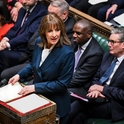Let’s start with the mechanics. The Tories won 57 seats that they did not win in 2017, but they lost 10, so they are up 47 net, from 318 to 365 seats.
A standard uniform change projection from the Great British shares of the vote (Con 44.7 per cent, Lab 33 per cent, Lib Dem 11.8 per cent, with the SNP on 45 per cent of the Scottish vote and Plaid Cymru on 9.9 per cent of the Welsh vote) would suggest the following seats outcome: Conservative 354, Labour 211, LD 17, SNP 46, Plaid three, Green one, and Others (from Northern Ireland) 18.
That would be a majority of 58, which would make for somewhat less dramatic headlines than the figure of 80, but is not profoundly different from the actual outcome: Conservative 365, Labour 203, LD 11, SNP 48, Plaid four, Green one, and then 18 Northern Irish MPs.
The fairly modest net differences in these totals, as well as individual differences in who won which particular seats, should be investigated and understood. But that is work for another day. The main point is that the actual seat totals achieved yesterday are broadly what you would expect given the total number of votes each party won, our electoral system and the geography of the vote in 2017. The shape of the new House of Commons, and especially the substantial Conservative majority, are not due to any peculiar pattern of different shifts in different seats. Rather, just as my recent Prospect article pointed out for both the 2015 and 2017 elections, uniform change projections have again proved to be a decent guide for the 2019 outcome.
If follows that the important questions for understanding how Boris Johnson secured his majority are why the Conservative vote was up 1.2 points, why the Labour vote was down 8 points, and why the Liberal Democrats were only up 4.2 points.
The answers as to what drove these shifts in vote shares will be much debated, but the movement should not have come as a surprise given they are broadly in line with the opinion polls for Great Britain, Scotland and Wales. Similarly, the seats outcome should have come as no surprise. That is not to say that I or anyone else knew in advance what the outcome would be. Rather, the eventual Tory tally was compatible with the range of forecasts from polls and other sources, albeit at the top end. (Actually the poll estimates of vote shares were very good on average. There is a bit more of an issue with the Conservatives outperforming the assumption of a uniform change based on those polls.)
But still the Tories were projected to win a comfortable majority. Had there been a polling error of the scale and magnitude of 2017 (a five-point underestimate of Labour) the Tory majority would have been considerably smaller, closer to 10, but still above zero. Had there been a 2015-style polling error (a 3.5-point overestimate of Labour and 3.5-point underestimate of the Conservatives) then we would instead have seen a larger Conservative majority, of around 116. The actual result was well within those bounds.
So we had polls that told us, broadly but rightly, we were in Tory majority territory; the next question is why we were in that ball park. Here the story is familiar and consistent from all the polls. Those who voted Leave in the 2016 referendum voted overwhelmingly for the Conservatives (73 per cent in the Ashcroft election day poll). Meanwhile there was a split among Remain voters—20 per cent Conservative, 47 per cent Labour and 21 per cent Lib Dem—and a similar split, too, among those who did not vote in the referendum. (See also this from John Curtice.)
Essentially at this election, Leavers united thwarted Remainers divided, as anticipated in another Prospect article, which I wrote at the very start of September.
Unite to Remain, Best for Britain and other campaigners on the Remain side tried to undo that division by encouraging tactical voting. But could tactical voting between parties that supported another referendum ever have prevented the Conservatives from securing their majority?
The pro-referendum parties had the advantage in ultimately attracting more voters. They (Labour, the Lib Dems, the SNP, Plaid and the Greens) won 52.1 per cent of the vote in Britain while the pro-Brexit forces (the Tories and the Brexit party) won a combined 46.8 per cent, with the remainder split between various independents.
However, the geography of the vote also matters. Recall that in the 2016 referendum the “Leave” vote was more evenly spread across the country while the “Remain” vote was more concentrated in the cities. As a result, it has been estimated that Leave won 64 per cent of constituencies with its 52 per cent of the overall vote. A similar pattern has transpired this week. The vote for pro-referendum parties was a bit more concentrated in “Remain” areas, while the pro-Brexit parties vote was again more evenly spread out across constituencies.
Consequently, despite securing less than half the vote at the general election, there was a majority, 328, of seats where the pro-Brexit parties collectively won more than the pro-referendum parties put together. On this basis, even with perfect tactical voting the pro-referendum side would not have been able to stop a first-past-the-post majority for the pro-Brexit side. It was not just internal division that weakened supporters of another referendum, but the electoral system also was against them.
That issue raises important questions about the operation of our democracy. This election was in large part about our response to the democratic mandate from 52 per cent of voters in the 2016 EU referendum. The results delivered 56 per cent of UK parliamentary seats for a government with 44 per cent of the UK vote, to deliver a Brexit deal that polls suggest is supported by just 34 per cent of the electorate.
Questions about both direct and indirect democracy in Britain will doubtless persist.
How did the Conservatives win?
A leading psephologist, and member of the exit poll team, on how electoral geography—and the voting system—helped to give Boris Johnson a majority of 80
December 13, 2019

Photo: Daniel Leal-Olivas/PA Archive/PA Images











